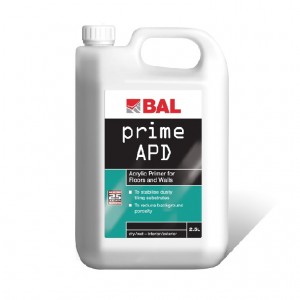“When do I need to prime?” “How many coats do I need?” are questions I’m often asked.
Priming can be an absolute minefield, but by following some simple rules it couldn’t be easier.
Before tiling, certain wall and floor backgrounds must be primed for a number of reasons including; to reduce porosity (absorbency) of backgrounds or bases (preventing the formation of air bubbles), to minimise risk of chemical reaction with cement-based adhesives and to add surface strength to friable (weak) surfaces.
Priming also helps prepare surfaces for waterproofing, or for preparing surfaces prior to the use of a levelling compound.
The following key substrates/backgrounds should be primed using BAL Prime APD, two coats neat – gypsum plaster (if using cementitious adhesive) and tongue and groove floorboards. Gypsum plaster can also be primed using BAL Bond SBR diluted 1:2 with water when using cement-based adhesives, or 1:4 if using BAL ready-mixed adhesives. If priming gypsum plaster before using ready-mixed products, BAL Prime APD can be used diluted 1:1 with clean water in one coat.
One to two coats of BAL Prime APD should be used for lightweight blockwork, and two coats (first coat diluted 1:1, second coat neat) for calcium sulphate or anhydrite screeds.
If required, i.e. the surface is dusty or friable, you may also want to consider priming cement:sand render, concrete and cement:sand screeds with one coat of BAL Prime APD to give the surface you are tiling to more strength.
BAL Bond SBR is also a useful product as a primer and can be used to prime the edges (but NOT the surface to be tiled onto) of the following backgrounds:
· Lightweight tile backer boards
· Calcium silicate boards
· Plasterboard
Remember to always seek further advice/guidance from board manufacturers.
If tiling on fibre-reinforced cement sheets, or plywood/chipboard, then we would always recommend priming the reverse side and edges with BAL Bond SBR. This helps protect the plywood from moisture penetration which could cause the board to swell.
When priming with two coats, it’s always good practice to apply the second coat at 90° angle to the first coat, with the one coat horizontally and one coat vertically (always allow each coat to dry). This ensures complete coverage of the background.
If you’re unsure whether to prime or not, it’s always worth your time consulting our Technical Advisory Service.
DOWNLOAD PRIMING GUIDE



